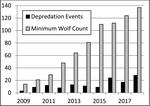Oregon's population of wolves increased by 10% last year. There are now at least 137 of them in the state, according the state's annual report on wolf management released Monday.
The number of wolf attacks on cattle and sheep, which also increased by 65%, for a total of 28.
However, Derek Broman, carnivore and furbearer coordinator for Oregon Fish and Wildlife, said since wolves' return in 2009, the overall rate of livestock attacks, known as depredations, has not kept pace with the minimum population.

Number of confirmed depredation events and minimum wolf count (2009-2018).
Source: Oregon Department of Fish and Wildlife
“The number of confirmed depredations do not the increase at the same rate as the minimum count of wolves,” Broman said. “So that’s pretty positive we’re getting more and more wolves but not the same rate of increase for depredations.”
Out of 16 packs in Oregon, all but one successfully reproduced last year. Wolves have also become better established in western Oregon, according to the report, with 15 total wolves and in three different groups.
Rodger Huffman, chairman of the wolf task force for the Oregon Cattlemen’s Association, said the state’s wildlife biologists have warned ranchers that Oregon’s wolf population has reached the point that livestock producers need to be on alert, even if no wolf packs are documented nearby.
“Let’s recognize that and adopt a plan that also recognizes that and is a little less on conservation and a little more on management,” Huffman said. “No matter what we as humans do this population’s going to continue to increase.”
Several environmental groups cheered the increasing wolf population but quickly shifted the focus to the potential for weakened protections.
Last month, the U.S. Department of Interior announced plans to remove federal Endangered Species Act protections for gray wolves in the Lower 48. That would lift protections for the newer populations of wolves in western Oregon and Washington.
Just last week, a report from Washington state wildlife officials documented a new pack on the western side of the state's Cascade Mountains for the first time in decades. Federal protections have already been lifted in the eastern parts of both Washington and Oregon.
“In light of federal attempts to strip wolves of protections, we are counting on Oregon to show leadership in wolf conservation and embrace the values of coexistence,” Dr. Sristi Kamal, Oregon senior representative for Defenders of Wildlife, said in a statement.
In a statement, Oregon Wild attributed the numbers to the resilience of wolves rather than state management. The group said the current total of 137 wolves closely resembled what the state projected as a minimum for the species’ population growth.
Oregon wildlife officials are in the midst of drafting and adopting a new management plan for wolves, guiding everything from population count methods to when and how wolves can be killed.
The process began with stakeholder meetings including livestock producers, hunters and wildlife conservation groups, but wolf advocates pulled out of negotiations, citing concerns with the process.
